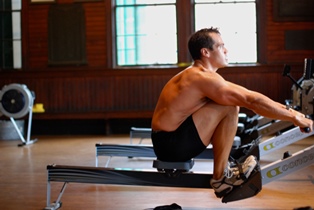Olympic Dreams

Every four years, the Olympics bring out wonderful stories of strength, courage, and passion. Concept2 recently met an athlete with a unique path to Olympic rowing. Two years ago, Daniel Marquardt weighed around 300 pounds and realized that he had to do something about it. So he bought a Concept2 Indoor Rower and started training. Once he realized he had potential in the sport, he set his sights on the Olympic Games. He’s currently preparing for the FISA Asian and Oceanic Olympic Qualifying Regatta in the heavyweight single scull (M1x) as a representative for Samoa.
Of course, no path to the Olympic Games is as straight forward as that, and Marquardt’s story is no exception. Marquardt is 36-years-old, a father, a husband, and a former collegiate football player who played at Brigham Young University as a 325-pound nose tackle. He grew up in California but is half Samoan. In high school, his weight coach was Mike Burgener, a Level 5 senior International Weightlifting Coach, who has had a significant influence on the development of CrossFit. “Coach B“ introduced Marquardt to the indoor rower more than two decades ago as "the gold standard of aerobic exercise."
Marquardt decided to start rowing to lose weight because it was convenient (he could row in the comfort of his own home and out of the cold winter), low-impact (it wouldn't bother his knee), and an efficient calorie burner (can burn more than 1200 calories per hour). By 2014, Marquardt had already lost 100 pounds with the help of rowing.

He was browsing the Concep2 Online Logbook and discovered that his steady state time for a 10k distance was in the 90th percentile of reported times. It was this realization that got him to explore the possibility of rowing competitively. He was encouraged to take a 2k “erg test.” In his first test, he rowed a respectable 5:58.
In 2015, FISA, the World Rowing governing body, targeted Samoa and American Samoa to develop rowing communities in Apia and Pago Pago through a program known as the World Rowing Islands Project. This program has a very successful pilot on the island of Vanuatu where a sustainable rowing community of high school-aged kids—mostly girls—is growing. FISA continues to support Samoan athletes with elite ambitions.
In Samoa, rowing, or fautasi, is extremely popular and ingrained in the culture. Fautasi typically includes over 50 rowers in a boat. Marquardt hopes to bring Olympic style “crew” to Samoa, with specific aspirations to create more opportunities for women. “Not only can it provide opportunities to participate, dream, and aspire but I believe it will create a pipeline of women's rowers into (US) NCAA rowing and the Olympics similar to what exists with American Samoa and American football,” explains Marquardt. In football, there’s a lot of raw power and strength. “Many Samoans are blessed with huge, powerful legs. Beyond that, height, long limbs, and the warrior mentality are all extremely important to training and competing in rowing.”
Marquardt is currently training in New Zealand, where he’s still learning to translate his indoor speed to rowing on water. He began training in a “bathtub” (learning boat) and it took months to transition into a racing single. He’s discovering technique challenges on water, but says, “my strength and aggressive style has probably been one of the most difficult challenges. As a nose tackle, my play was defined by aggressive disruption. In rowing, smooth is fast, this was a huge paradigm shift for me.“
Marquardt, an investment banker, resides with his wife and daughters outside of Washington, DC, and trains there with the US National team.He needs to finish in the top seven at the Olympic qualifier to race at the Olympics. Best of luck in the upcoming months!
If you'd like to learn more about Daniel, visit his blog at rowdanielrow.com and his Facebook page.
